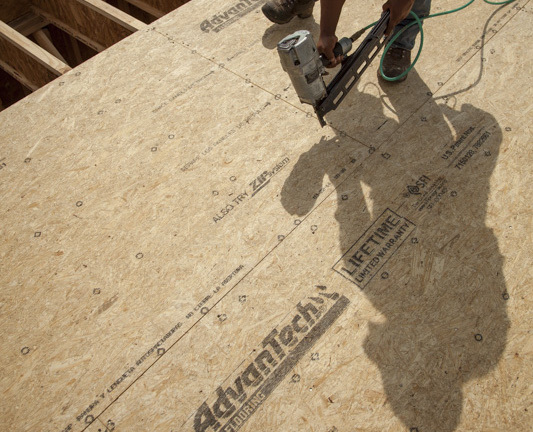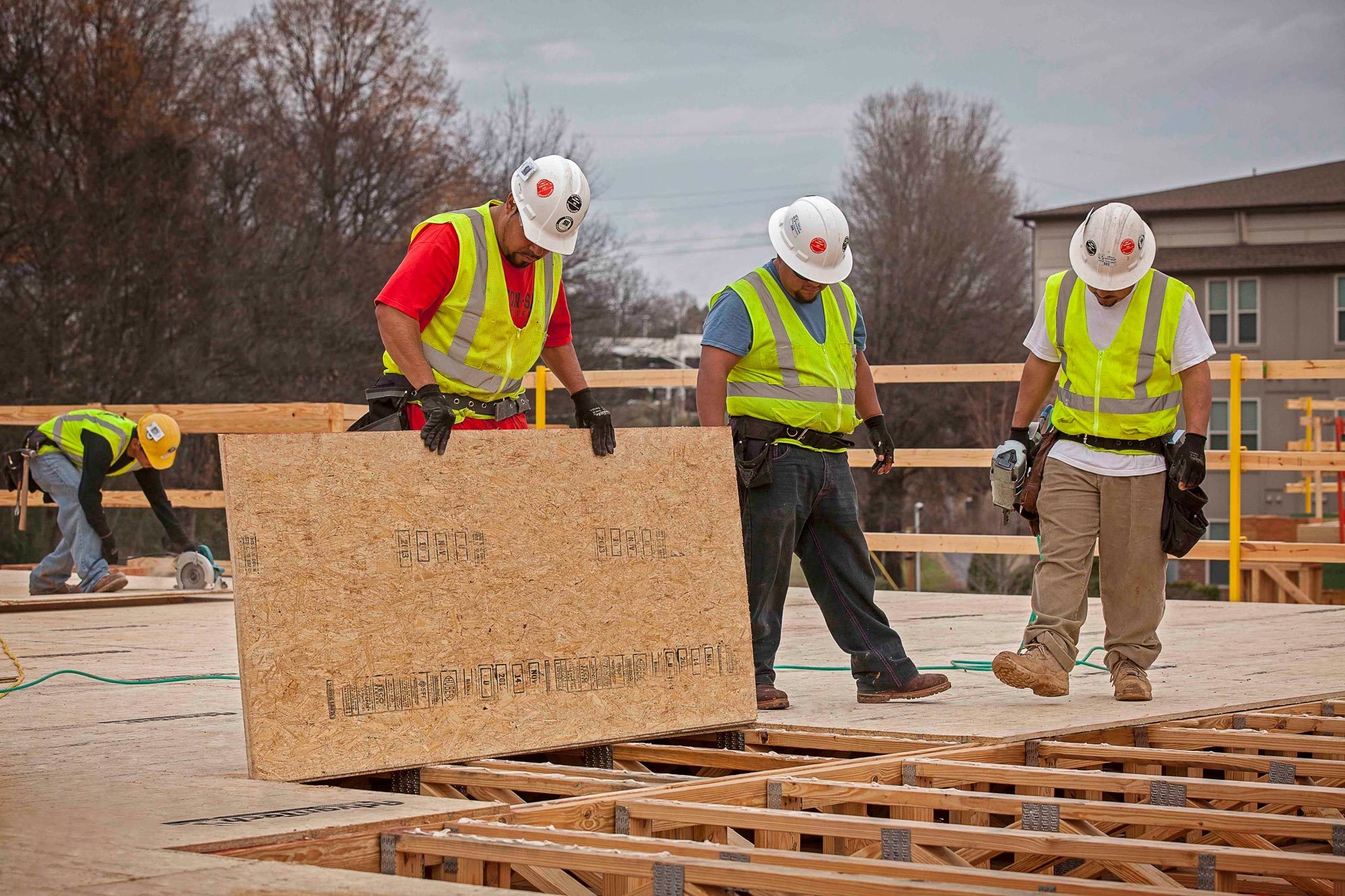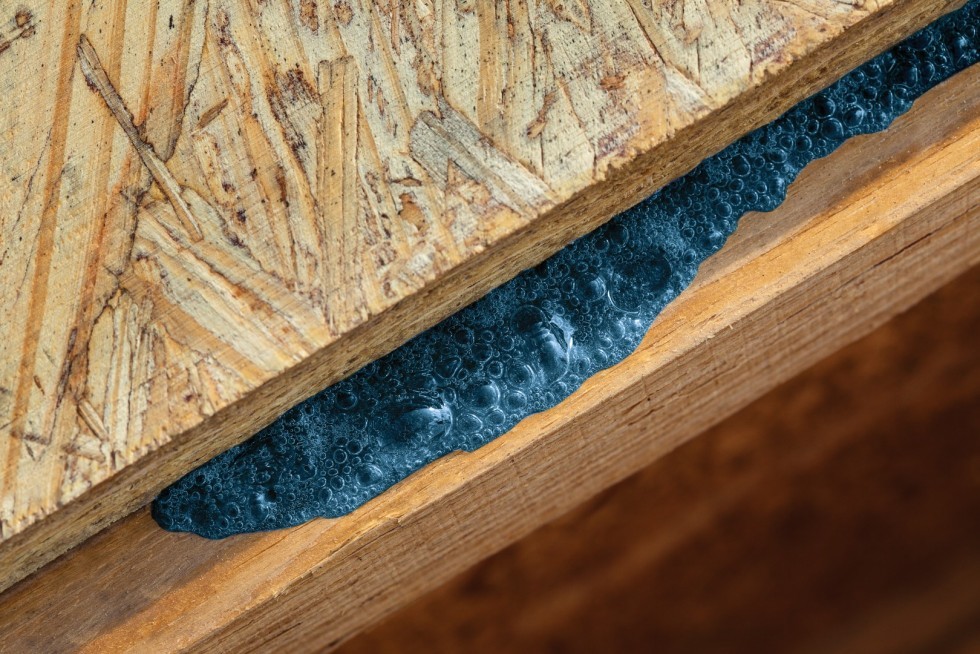
Your Detailed Guide to Installing Quiet Subfloors
7 Min Read April 18, 2017
Squeaky floors are a common complaint – just do an online search on floor squeaks and remedy after remedy from homeowners associations to This Old House come up in search results.
A recent Builder magazine article listed floor squeaks among the top 11 most common callbacks. To help avoid a squeaky floor callback, here’s a few subflooring secrets to consider, to reduce the chance for squeaks on your next build.
Luxury you can’t see is quality.
Current building code standards are designed to make sure floor systems can adequately resist weight of a given design. However, they are not necessarily written to specifically eliminate squeaks, bounce or uneven floors.
Proper installation plays an important part in flooring performance, as does choosing materials. When it comes to selecting the support for your finished floors, typical plywood and oriented strand board (OSB) subflooring satisfy minimum standards in current building codes, but builders and their clients have a choice to use high-performance materials in critical unseen places that can affect long-term flooring performance.
Choosing subflooring with above-code strength, stiffness and fastener-holding power values can help reduce construction delays and the risk of callbacks for squeaky, bouncy floors.
What's Important for Subfloor Panels
There’s a homeowner tendency to scrutinize cosmetic details of the home during a build to make sure the overall design and function convey luxury. Spending time discussing the importance of high-performance materials in unseen places, can be a little trickier, but can make a long-term difference in the comfort of a home. Remember, luxury you can see can be pretty, but luxury you can’t see is quality.
Here are four qualities you should look for in subflooring material to help ensure quiet, stiff floors:
- Strength: How much weight a panel can hold.
Subflooring comes in a variety of materials. Typical commodity plywood and OSB is historically known to provide an adequate base to meet the minimum design floor loads from the building code at the time the home is built.
To be sure the structural subfloor can support any loads put on it for years to come, builders can choose subflooring products that are stronger and warranted for the lifetime of the home.
Today’s high-performance engineered wood panels have advanced “recipes” of high-wood density and sophisticated resin technology that help them provide an exceptionally strong foundation for hardwoods, tile, stone and you.

- Stiffness: How much the panel will deflect up and down.
While it’s important that subflooring is strong to resist weight distributed across its surface, panel stiffness is also important to make sure subflooring maintains a flat, even consistency. Subfloor panel stiffness plays an important role in how satisfied homeowners are with their finished flooring.
Wood density and resin composition in engineered wood panels play a role in panel stiffness just like they do in determining strength. High-performance panels like AdvanTech® subflooring also have a specially engineered wood strand orientation pattern used in manufacturing for optimal stiffness to help eliminate bouncy sagging floors.
- Fastener Holding Power: How well subflooring holds nails, screws or staples.
Some commodity subflooring products may lose their ability to hold fasteners in place over time, especially if exposed to moisture during construction. During its unique manufacturing process each wood flake used to make AdvanTech subflooring panels is coated with advanced moisture-fighting resins that not only increase its moisture resistance throughout the panel, but also creates a strong material bond in every square inch of the panel.
This kind of panel design and manufacturing process helps AdvanTech panels grip and hold fasteners in place to reduce the risk of movement between subflooring, joists and floor coverings, which is how squeaks occur.
Choosing screw shank or rink-shank fasteners over smooth shank nails can also help reduce the chance of fasteners loosening and allowing for movement that can lead to squeaks over time. Choosing a panel with a fastening guide to help make sure the appropriate spacing and to avoid “shiners” or misplaced fasteners that may miss the joists, is another best practice.
- Moisture Resistance: Standing up to jobsite conditions.
Lower quality subflooring can swell or delaminate when exposed to water during construction. This can create uneven panels that can lead to loosened connections and bonds over time which increases the chance of squeaks. Sanding swollen, uneven panels during construction is a common practice, but it can cause costly construction delays. Panels engineered with next-generation ingredients and processes make these high-performance panels so moisture resistant they’re backed by a 500-day No Sanding Guarantee.[1]
Not all engineered wood panels are the same. AdvanTech® subflooring is the only structural engineered wood panel with documented design values above code minimum requirements (PS 2-10). Evaluation Service Report ESR-1785 reports AdvanTech panels have better strength, stiffness and fastener-holding power than commodity OSB or plywood panels of the same thickness.[2]
In fact it was AdvanTech subflooring that introduced this “third category” of subflooring that performs distinctively differently from commodity OSB and plywood 20 years ago.
How to Adhere Your Subfloor Panels to Joists
To glue or not to glue? The answer: Glue. Although using a subfloor adhesive (or subfloor glue) is not required by code, it is a standard practice that can help prevent floor squeaks by reducing the chance for movement at the panel-to-joist connection. A quality subfloor adhesive will also increase the overall stiffness of the floor.
A quality subfloor adhesive will also increase the overall stiffness of the floor.
Weather can play a major role in how well traditional cartridge-applied adhesives work. It’s important to store glues at the correct temperature, especially during the colder months. Adhesives should be kept warm during the winter, because when cold, they do not adhere as well and become difficult to use which can lead to bad application.
Traditional cartridge construction adhesives can be harder to use during cold weather – slowing down the installation process and making the job harder than it needs to be. But using a polyurethane spray-foam adhesive like AdvanTech™ subfloor adhesive is quick and easy to use. It can adhere to wet and frozen wood and cover up to eight times more panels per can.[3]
AdvanTech subfloor adhesive starts as a foam and settles into a high-strength gel adhesive. It creates a bond that goes beyond industry performance standards[4] and is so strong that when used with AdvanTech subflooring as part of an AdvanTech™ Subfloor Assembly, it’s backed by a Squeak-Free Guarantee.[5]

Before applying an adhesive, make sure the surface doesn’t have any standing water and is free from oil and grease. Apply only enough adhesive for 2-3 panels at a time. With AdvanTech subfloor adhesive, you have a 20 minute open time to install panels.
AdvanTech subfloor adhesive is fast and easy to install. This is important because easier installation means better application which leads to stiffer floors.
The unique blue color of AdvanTech subfloor adhesive lets you see exactly where the adhesive is and how much. It’s a great feature for ensuring proper and sufficient application. Watch the full application instructional video at AdvanTechSFA.com.
Last, but not least
Double check your work. Before frame inspection, walk the subfloor deck looking for missing fasteners and any possible inconsistencies.
Taking the best steps towards building a quiet subfloor means you can give homeowners peace of mind of avoiding squeaks and creaks that can disturb everyday life’s tip-toe moments.
[1] Limitations and restrictions apply. See www.huberwood.com/advantech/residentialwarranty for details.
[2] See Evaluation Service Report published by the International Code Council Evaluation Services Office, ESR-1785 for details.
[3] Coverage: One 24 oz. can of AdvanTech subfloor adhesive yields approximately 400 linear feet of gel adhesive at ½” bead compared to applying a 28 oz. cartridge adhesive at 3/8” bead. Coverage varies based on bead size and weather conditions.
[4] Exceeds ASTM D3498; dry, wet, frozen and gap filling adhesion tests.
[5] Limitations and restrictions apply. See Squeak-Free Guarantee for details on AdvanTech Subfloor Assembly requirements.

